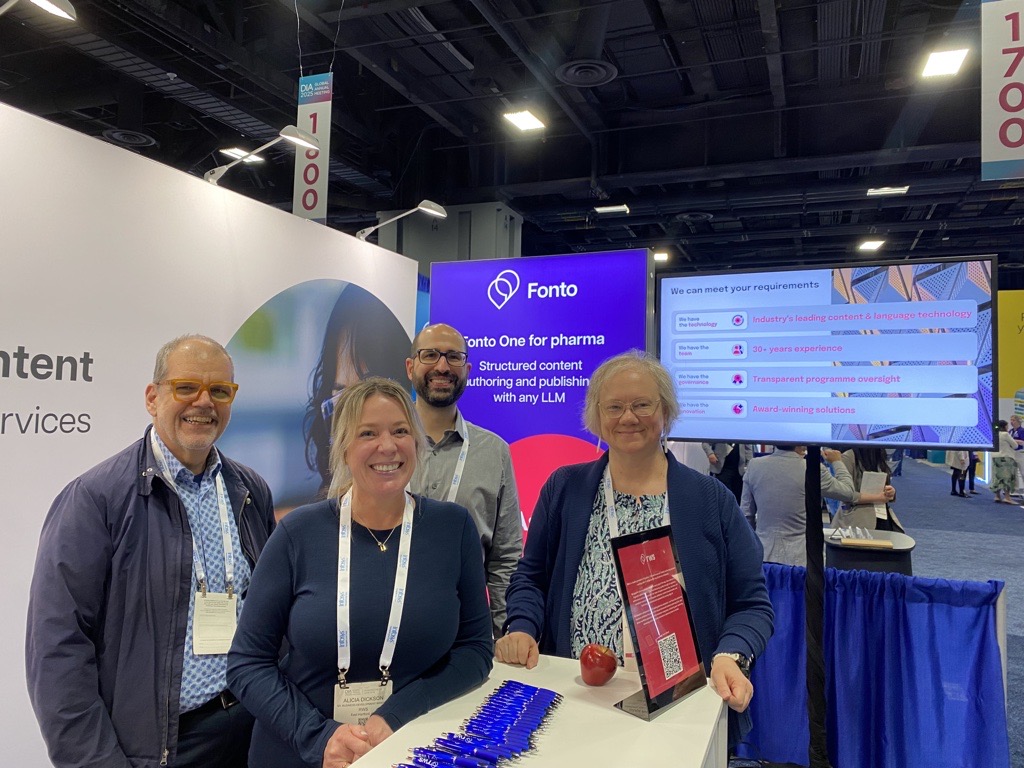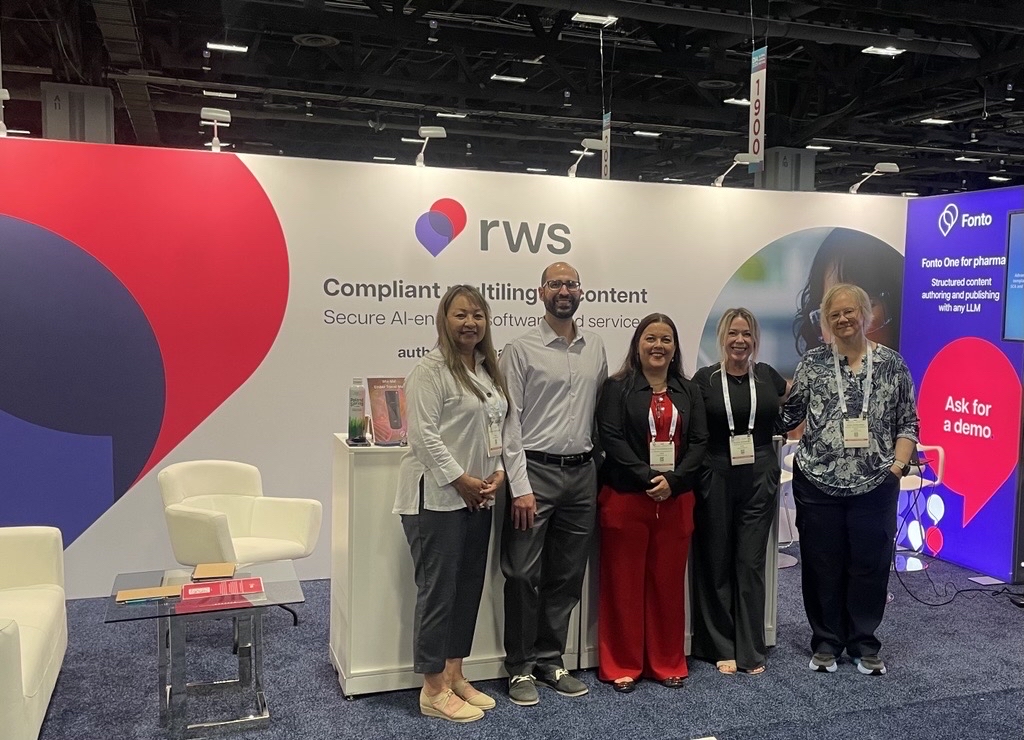DIA’s Annual Global Meeting is always a great opportunity for sponsors, service providers and health authorities to learn from one another, and this year’s meeting was no different. This was certainly not my first DIA Global Meeting, but it’s my first in a while as part of an organized team.
I have been working on projects related to data standards and interoperability, content reuse and automation for several years now, but this was the first time I navigated DIA (Drug Information Association) through that specific lens. It’s an interesting time to have that focus.
Here are a few of my observations about the meeting and about a couple of trends in the industry.
The challenge of working with content that is not fully componentized
Walking through the Exhibit Hall and listening to the Innovation Theatre presentations, a number of vendors offered impressive solutions. The majority of these are plug-ins or overlays to Microsoft Word. That’s understandable given that Word is the comfort zone of many of our users.
The challenge for Word-based solutions is to realize the full benefit of Structured Content Management. Once the content is authored, what processes and platforms will be available to store, reuse and govern that content?

Why moving to real structured content authoring matters
The full benefit of moving to Structured Content Authoring (SCA) is realized through its ability to support verbatim and derivative reuse (e.g., in other documents or future applications), or to translate and adapt content components to meet the needs of local health authorities and other users.
These points were driven home for me during several sessions. For example, the use of ISO standards for the Identification of Medicinal Products (IDMP) has taken some time to be adopted. Now the EU, US and other regulators are incorporating IDMP in their guidelines to ensure the unambiguous identification of products across jurisdictions. While the industry creates vast quantities of product information, consistency and strong governance of that information will be critical forsuch situations as managing drug shortages. This was pointed out by Ron Fitzmartin and others.
In another session about Building a Regulatory Landscape to Support CMC Innovation, representatives from sponsors and regulators discussed the importance of new models of collaboration beyond individual Quality Agreements. With part of the focus on Product Life Cycle Management and the implementation of ICH Q12 (and M4Q R2), it’s clear that the way content is governed, reused, updated and localized will remain critical.
The need for strong governance was a dominant theme of a session on developing a Pharmaceutical Quality Knowledge Management (PQKM) platform to support global submissions. This session provided an overview and an update on the ICMRA’s (International Coalition of Medicines Regulatory Agencies) work to recommend an approach to governance and a market consultation model. It is difficult to envision how challenges related to data governance and data residency requirements will be met without an infrastructure of robust data and content management platforms.
Several sessions emphasized the importance of HL7 FHIR-based submissions, including CMC, labeling, and clinical data. Whether it’s the HL7 Pharmaceutical Quality – Industry (PQI) project or the Common, electronic Harmonized Protocol Template (ICH M11) and the Vulcan Accelerator, all roads seem to point to the need for FHIR-based outputs.
SCA with Artificial Intelligence (AI) has definitely arrived
There were also dozens of applications of Artificial Intelligence shared, from machine learning to generative AI (Gen AI). The remarkable evolution of AI’s place continues. In a few short years, it’s gone from a revolutionary idea to dramatic efficiency improvements. Now, organizations expect not only that AI will deliver improvements, but also that solutions will be able to clearly anticipate and articulate those dramatic gains.
The most memorable presentation for me came from a pharmaceutical company who has leveraged both SCA and AI to achieve a dramatic acceleration in the creation of its Clinical Study Reports, from 15 weeks to 1 or 2 weeks. As well as providing the meeting’s most quotable quote, “SCA is modular, not linear,” the presenters emphasized that this journey is not just about choosing the right technology.
Change management – essential for adopting SCA and AI-based solutions
Organizations must also pay ample attention to people, processes and their organizational culture if they want to realize the full potential from their investment.
These challenges cannot be underestimated. It’s important to have a clear understanding of the processes that will be transformed by the move to SCA and the different roles or personas that will be impacted. Those could be primary users of the new system, secondary contributors, or “bystanders” whose work could be impacted even if they’re not directly participating. While “culture” is not often articulated as a consideration, in our experience it’s important to understand at least a couple of key aspects:
- How are decisions made and communicated? Is the organization used to centralized decision-making and expected to align, or is the culture more consensus-based with a need to bring everyone along?
- Do key participants feel they have a vested interest in the success of the project? Do they trust that the changes are being made for the right reasons, including bringing treatments to market faster and with better quality documentation?
It is critical to anticipate these discussions, so they can be navigated as they arise. Projects will benefit from extensive experience implementing SCA and GenAI from a variety of different industries, even if these solutions are relatively new to pharma.
Key takeaways from DIA 2025
This year’s DIA Global Meeting made it clear that pharmaceutical companies, Health Authorities and software providers all appreciate the opportunity that SCA and GenAI represent. Done correctly, the benefits of SCA go far beyond just restructuring documents. By enabling faster document development through effective reuse and leveraging GenAI, the industry can realize a significant ROI. Working with structured content also enables companies to better govern their content, making it available for a number of use cases across geographies and throughout the product lifecycle.
The sessions made it clear that success depends on more than just choosing a software platform or the best MS Word plug-in. Companies need to have an in-depth understanding of the use cases they’re working on, the types of content that are in scope, a deep appreciation of the people and processes that will be impacted, and the cultural barriers and enablers that need to be taken into account.
Fonto One’s integrated authoring platform provides capabilities that address the technical requirements that I’ve outlined. Just as importantly, RWS brings extensive experience implementing SCA in other regulated industries, and we appreciate both the similarities between those industries and the challenges that are unique to pharmaceutical companies.

If you would like to learn more
SCA and GenAI are capabilities whose time has come. If you would like to discuss this with me and our team, or to learn more about SCA, GenAI, or how Fonto One and RWS can help, please contact us.

Todd recently joined the Fonto One team as Industry Lead for Pharma. He has spent his 30-year career in clinical operations and drug development for large pharma and contract research organizations. Todd has spent the last few years working on projects related to content reuse and automation, including several cross-industry collaborations on data standards, digital protocols, and patient clinical trial matching.
